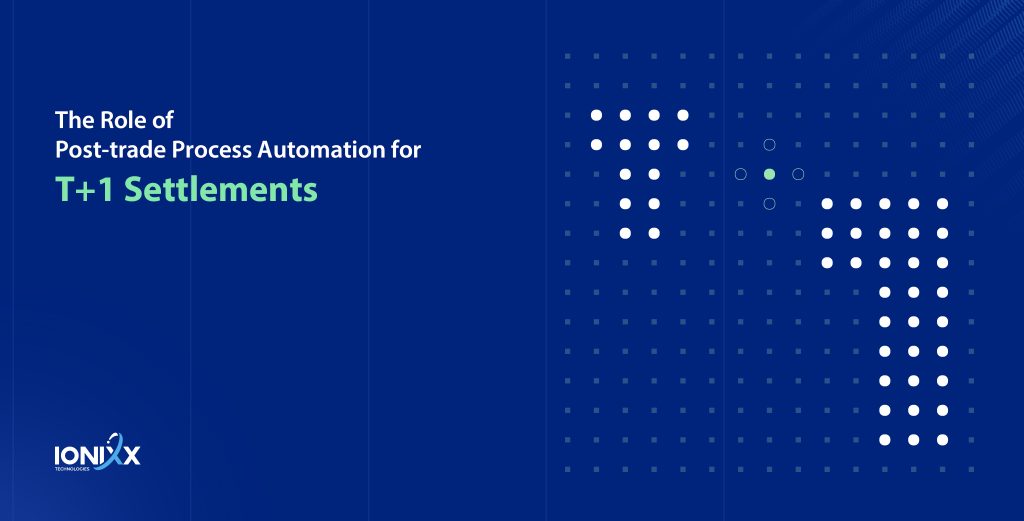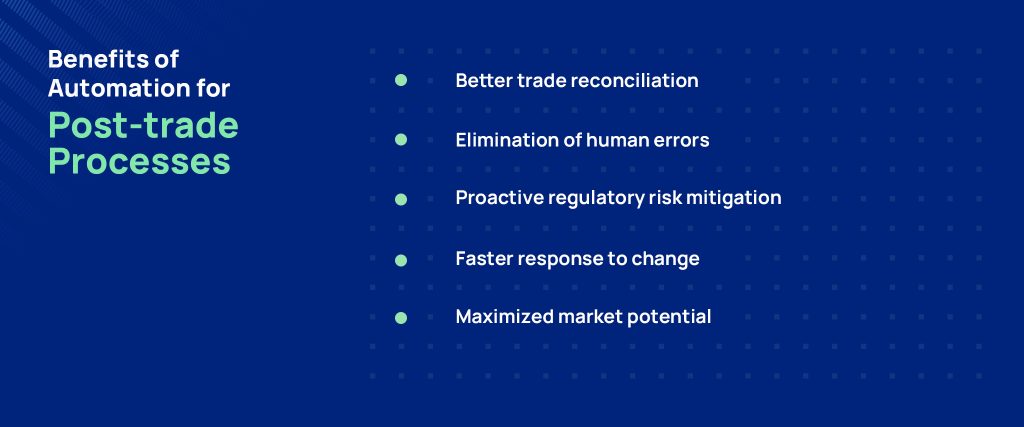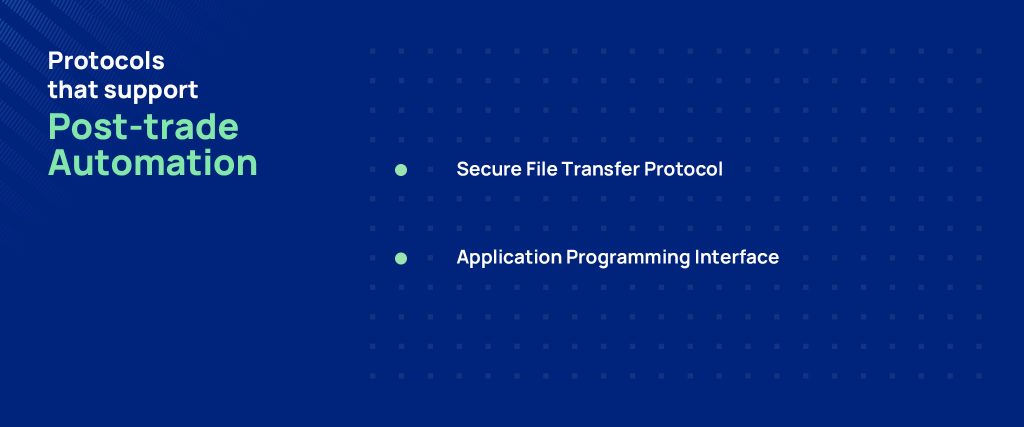
Highly volatile capital markets, an ever-evolving regulatory landscape with the U.S. Securities and Exchange Commission (SEC) laying out newer regulatory mandates every so often, and of course the growing demand to expedite settlement cycles from T+2 to T+1 by May 2024.
These events have brought back the conversation on technology innovation and automation for post-trade settlement processes. Same-day affirmation (SDA) and straight-through-processing (STP) play key roles in accelerating the journey to T+1.
To understand the scope for automation and its impact on T+1, it is important to understand the processes that comprise the T+2 cycle.
What Does The Current T+2 (two-day settlement) Cycle Look Like?
Currently, most trades are settled on a T+2 basis, meaning it takes two business days for the buyer and seller to exchange payment and securities. The objective that the Depository Trust and Clearing Corporation (DTCC) sets to achieve is for trade settlements to take just 24 hours, paving the way for a T+1 settlement.
Consider the analogy of a factory assembly line. Just as automation has transformed the manufacturing industry by streamlining and speeding up the production process, automation in the post-trade settlement workflow can similarly transform the post-trade cycle, allowing firms to execute trades more quickly, accurately, and efficiently (T+2 to T+1).
The T+2 trade settlement cycle encompasses a series of steps and processes such as clearing and netting, trade allocation, reconciliation, trade reporting, and settlement.
- Trade allocation and netting is the process of allocating trades to different clients based on the instructions given by the trader. This involves breaking down trades into smaller lots to suit each client’s investment goals.
- Trade confirmation and matching is the process of verifying the details of a trade, ensuring that the trade is executed as per the trader’s instructions, and confirming the terms of the trade with the client.
- Trade reconciliation is the process of reconciling trade data between the parties involved in the trade to ensure an accurate and complete settlement.
- Trade reporting involves the reporting of trade data to regulatory bodies and other stakeholders for transparency and compliance.
- The settlement involves the actual transfer of cash and securities from the buyer to the seller, and vice versa, as per the agreed terms of the trade.
Why T+2 to T+1 Now?
By reducing the settlement time for trades, a T+1 cycle can help reduce counterparty risk, increase liquidity, and lower market participants’ operational costs. Crucially, moving towards a T+1 cycle can also help prevent systemic risks that could have a negative impact on the financial system as a whole.
How Automation Can Help – Impact Areas in Post-Trade Processing
The below table represents how automation can play a huge role across the entire trading ecosystem; delivering a specific impact for every trade participant in the trade settlement lifecycle.

Key Benefits of Automation for Post-Trade Processes
The following table illustrates how automation positively impacts every market participant across the trading lifecycle.
| Key Participant | Impact Area | Possible Automation Benefits |
| Buy-Side Firm | Operational Efficiency | Automation can help improve the speed and accuracy of post-trade settlement activities, allowing for faster confirmation and settlement times. |
| Cost Reduction | Automating post-trade settlement activities can help reduce operational costs associated with manual processing and human error. | |
| Operational Efficiency | Automating post-trade settlement activities can help improve efficiency, reduce the likelihood of human error, and allow for faster processing times. | |
| Broker-Dealer | Risk Mitigation | Automation can help mitigate operational and counterparty risk associated with post-trade settlement activities due to the reduced potential for manual errors and system delays. |
| Scalability | Automating post-trade settlement activities can make it easier for broker-dealers to scale their operations in response to changes in trading volume or volatile market conditions. | |
| Investors | Turnaround Efficiency | Automating post-trade settlement activities can help with faster liquidity, accelerating trade processing times from 2 days to 1 day. |
| Improved liquidity | Automation can help investors manage trades better with quicker settlement times. |
Improved operational efficiency, better regulatory compliance
An automated post-trade settlement process increases operational efficiency. Since participants in the post-trade settlement cycle can access information on trades, settlements, and assets at any time, and from any location, real-time trade processing is achieved. This in turn translates to efficient regulatory reporting. Automation of post-trade workflows can enable seamless data transmission through APIs, facilitating real-time data transfer to regulatory bodies. This ensures that the data transmitted aligns with changing regulatory requirements.
Real-time data processing, improved risk management
Automating the post-trade settlement cycle improves compliance with regulatory requirements, including AML, KYC, and such. Automation ensures that all steps the regulation requires are performed, thus preparing firms to mitigate risks in real time.
The ability to automatically record and organize data can make regulatory audits less hectic. This cuts down on compliance costs while improving business processes.
Fewer trade fails, better reconciliation and settlement
With automated processes, reconciliation, and settlement systems are also more adept at providing clarity with the processing of trades. Automating this process cuts down on communication time with counterparties, and clearing organizations. The advantage of improved settlement is fewer trade fails, and faster settlement cycle timelines.
Enhanced client experience, improved trust, and transparency
On the client side, automation enhances the customer experience and provides more efficient services. Automating post-trade settlements enables faster settlements, real-time visibility of trades, and lower transaction fees. It removes manual intervention on post-trade cycles, thus improving client satisfaction and reducing the potential risk of human errors.
Better poised for innovation, greater scalability, and flexibility
Finally, as with any modern technology, automating the post-trade settlement cycle makes the entire ecosystem scalable and adaptable. Any manual process can become more complex when there are higher volumes of trades. This makes scalability an important consideration. Automated platforms allow for flexible workflows that can make it easier to handle increases in transaction volumes. Adaptability to changing regulatory and industry demands is also a crucial aspect of automation. Automated methodologies will ensure that you can remain compliant and up-to-date while also minimizing organizational disruption.
Are You Ready to Move from T+2 to T+1?
While post-trade automation is crucial in the journey from T+2 to T+1 settlement, the paradigm shift towards automation is not just about streamlining processes. It represents a fundamental change in how buy and sell-side firms operate and adapt to a rapidly evolving landscape.
That said, the T+2 to T+1 migration requires a holistic approach that goes beyond technology upgrades. A commitment to ongoing innovation and monitoring core parameters that track operational efficiency is crucial.

Moving into The Future
The path to T+1 settlement demands collaboration between industry participants, technology providers, and regulatory bodies.
Is your firm yet to begin its T+2 to T+1 journey? Are you deliberating on the right time to accelerate your digital transformation? At Ionixx, we are here to help you provide post-trade automation solutions that drive efficiency and optimization. We’ve been in the industry for over a decade, and have helped both buy and sell-side firms to modernize their post-trade operations, including the move to T+2 and increase straight-through processing rates. Get in touch.


